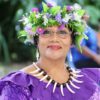Nauru Travel Guide
Welcome to the taste2travel Nauru Travel Guide!
Date Visited: March 2020
Introduction
At just 21 km2 (8.1 sq. mi), Nauru is the smallest republic in the world, being slightly larger than the 20 km2 of land which is occupied by John F. Kennedy International Airport in New York City.

A view of the limestone pinnacles at Anibare Bay.
A small, isolated coral island, Nauru is surrounded by a shallow, rocky, coral reef. This Pacific nation, which lies well off the beaten tourist track, lacks many of the tourist facilities of some of its larger neighbours, such as Fiji.
There are no resorts, no fancy restaurants or any decent swimming beaches. There are very few services which would cater to visiting holiday makers, although an Office of Tourism was scheduled to open at the Menen Hotel in April of 2020.

Have to love wonderful Nauru!
It’s interior plateau, which is known as ‘Topside’, occupies 80% of the island, and has been the site of unfettered phosphate mining for more than a century. This has left Topside looking like a lunar wasteland.

Exposed limestone pinnacles on Topside, the remnants of a former phosphate mine.
While current visitor numbers are not available from the United Nations World Travel Organisation (UNWTO), it is claimed that Nauru is the least visited country in the world, attracting around 200 visitors per year.
By comparison, Tuvalu (click to view my Tuvalu Travel Guide), which also claims to be the least visited country in the world, attracted 2,700 visitors in 2018, although most of these were business travellers.

A view of Anibare Bay, Nauru.
While Nauru is not your standard travel destination, it is an engaging and surprising island. This is the island which was named ‘Pleasant Island‘ by the first European visitors, after their favourable encounter with the locals. The real asset of Nauru are the Nauruans themselves, who are warm, welcoming, friendly and kind.
Nauru has plenty of potential as a tourist destination and it seems the current government is determined to develop that potential. Now is a great time to visit Nauru, before the hordes arrive.

A playground on Nauru.
Location
Yaren, Nauru
Nauru is a small, oval-shaped, raised coral island, located in south-eastern Micronesia, 53 km (33 miles) south of the Equator.
Truly remote, Nauru’s closest neighbour (click the links to view my travel guides for the countries listed) is Kiribati whose most westerly island, Banaba (population: 295), lies 300 km (186 mi) to the east of Nauru.

A signboard outside of the Capelle and Partner supermarket indicates distances to different countries from Nauru.
More distant neighbours include the Solomon Islands which lies 1,300 km (800 mi) to the southwest; Tuvalu which is 1,395 km (866 mi) to the southeast; Marshall Islands which lies 973 km (605 mi) to the northeast; Papua New Guinea which is 2,628 km (1,633 mi) to the southwest; Vanuatu; which lies 1,651 km (1,026 mi) to the south and the Federated States of Micronesia which is 2,019 km (1,254 mi) to the northwest.

A view of Ewa beach, which lies on the north coast of Nauru.
A major logistical and lifestyle hub for Nauru is Brisbane, Australia which is 3,341 km (2076 mi) to the southeast.
Brisbane airport serves as a base and maintenance centre for Nauru Airlines, while wealthier Nauruan’s travel to Brisbane on shopping trips, send their children to tertiary institutions in the city and even maintain 2nd homes there.
Brisbane is also the location of a Nauru Consulate General (see the Visa section for more details), one of just four diplomatic missions around the world.
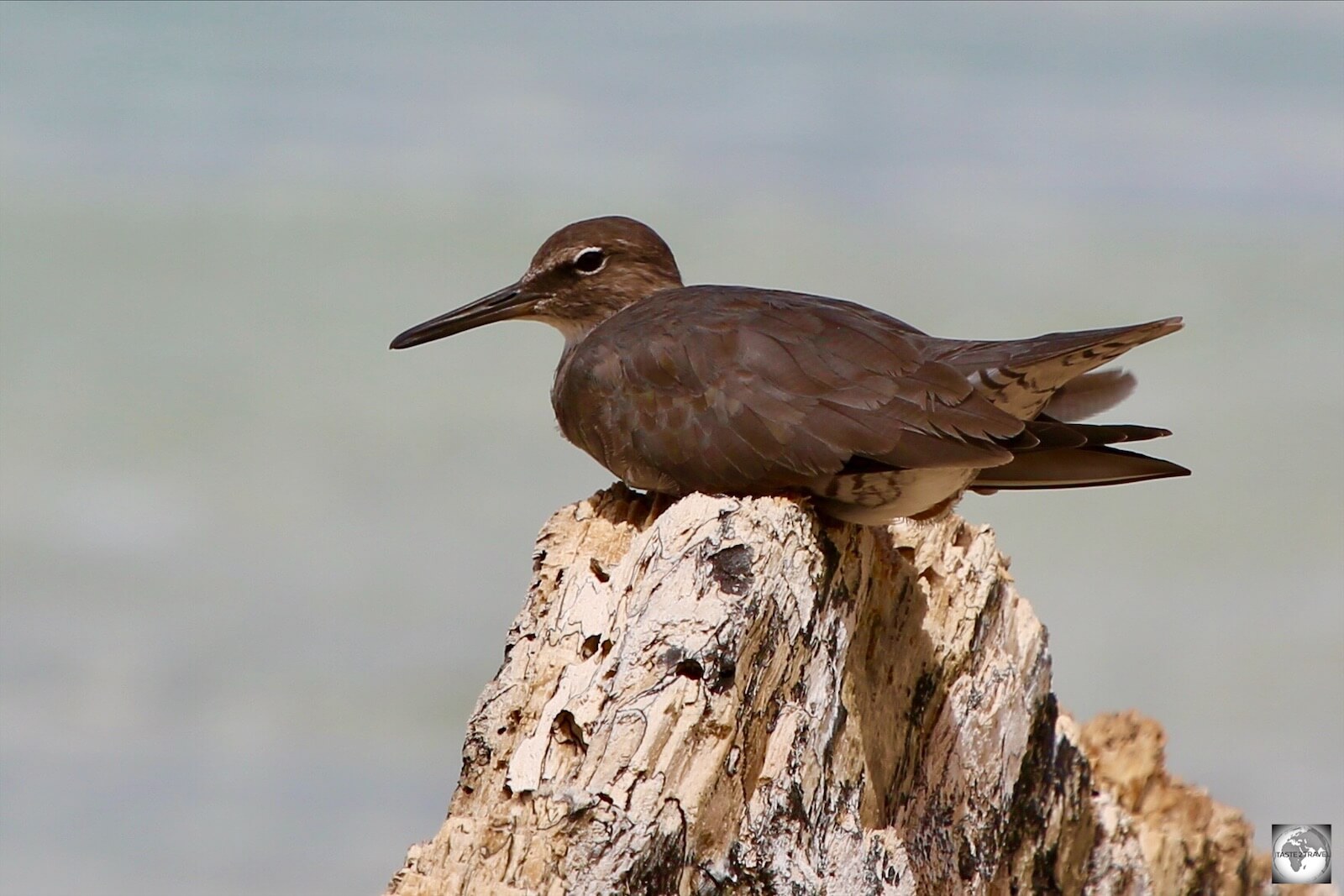
The only wildlife to be found on remote Nauru are the occasional migrating seabird such as Brown Noddy’s, which are a common sight on the beaches.
Micronesia

A map of the region of Micronesia.
Source: Wikipedia
The region of Micronesia lies between the Philippines and Hawaii, occupying a large patch of the Central Pacific, encompassing more than 2,000 islands, most of which are small and many of which are found in clusters.
The term Micronesia is derived from the Greek words mikros (meaning ‘small’) and nēsoi (meaning ‘islands’). The first usage of the term is attributed to Jules Dumont d’Urville, a French explorer and Naval officer who explored the region in 1832.
The region includes, from west to east, Palau, Guam (click to read my travel guides), the Northern Mariana Islands, the Federated States of Micronesia, the Marshall Islands, Nauru, and Kiribati. With the exception of Nauru and Kiribati, all the islands of Micronesia lie to the north of the Equator.
Nauru holds the distinction of being the first Micronesian country to become a sovereign nation, gaining independence in 1968.

The Nauruans are a mixture of Micronesian, Polynesian and Melanesian descent.
The origin of the Nauruan people has not yet been fully determined. They are a mixture of Micronesian, Polynesian and Melanesian descent and are comprised of 12 tribes, as symbolised by the 12-pointed star on the Nauru flag (see the ‘Flag‘ section below).
The original settlers to the region were Austronesian peoples who migrated from Southeast Asia and Taiwan into present-day Micronesia around 1,500 BC.

A map showing the three distinct cultural regions of the Pacific.
Source: Wikipedia
From Micronesia, different migrations at different times in history took these Austronesian explorers further into the vast expanses of the Pacific ocean, where they eventually settled the islands of Melanesia (first migration around 1,300 BC) and finally the more distant islands of Polynesia (first migration around 800 BC), finally reaching the most easterly island, Easter Island, around 700 – 800 AD.
Following are a list of travel guides I have written for each of these three regions:
Melanesia
Micronesia
Polynesia
People

The children of Nauru are incredibly friendly and love posing for the camera.
The history of human activity on Nauru began roughly 3,000 years ago when twelve Micronesian and Polynesian clans settled the island. For most of its history, the tribes of Nauru enjoyed a quiet, secluded existence on their remote paradise island.
Activities included aquaculture (including operating an ancient version of a fish farm in the Buada lagoon), harvesting coconuts and savouring the occasional Brown Noddy (I was assured they are tasty).

Young girls on Nauru.
The first European contact came in November of 1798, when British Captain John Fearn, of the whaling ship ‘Hunter‘, approached the island. The crew did not land, nor did any locals board the ship, but many canoes came to welcome the ship, which left a favourable impression and resulted in Fearn naming the island, Pleasant Island.

Boys posing in front of a giant flag of Nauru which adorns the wall of the Civic centre.
As of July 2018, independent Nauru was home to 10,670 residents, making it the second least populated sovereign state, after the Vatican City which has a population of just 799 pious souls!
The Nauruans are wonderfully laid-back, relaxed, friendly and always made me feel welcome, a very pleasant island indeed!
Miss Nauru 2020

‘Miss Nauru Cenpac 2020’, Ofa Fay Temaki competing in the final evening of the competition.
My visit to Nauru coincided with the ‘Miss Nauru 2020‘ contest which saw eight contestants competing for the title of Miss Nauru 2020.

One of the judges at the Miss Nauru 2020 contest, Ms Ruby Amram.
The finale of the competition saw the contestants competing over three nights in different fashion categories, which included best sarong, white dress, traditional island couture and formal wear. They were also asked a series of questions and judged on their talent, singing ability and interview skills.

Some of the contestants represented different districts, such as Miss Yaren – Brutay Tatum.
A highlight of the Nauru cultural calendar, the final night of the competition drew a large, enthusiastic crowd, including the president, Lionel Rouwen Aingimea.

Miss Menen, My-Gem Tatum, represented the district of Meneng, which is home to the Hotel Menen.
Nauru Music

Local performer, James Vaele, keeping the crowds entertained during the Miss Nauru 2020 competition.
There’s a small, budding music scene on tiny Nauru and during the Miss Nauru 2020 contest, the crowds were kept entertained by a local singer/ songwriter, James Vaele who has written a number of songs which are dedicated to his island home.
One of my favourite songs from James is ‘Postcard for Nauru‘, which features a catchy tune and lots of scenery from the island. You can view his YouTube video here.
Another local song, ‘Nauru Island Home‘ is also very catchy and provides more scenic views of the island.
Flag

The flag of Nauru.
The flag of Nauru illustrates the country’s geographical position, one degree south of the Equator. The gold stripe represents the equator, which is set on a blue field for the Pacific Ocean.

A flag of Nauru which is displayed in the lobby of the Menen hotel.
Below the equator, a 12-pointed, white star represents Nauru, with each point symbolising the twelve indigenous tribes which settled the island. The colour of the star is ‘Phosphate white’, representing the islands’ major resource and most important export.

The Nauru flag flying alongside the Taiwanese flag. Taiwan provides aid to the island in exchange for Nauru recognising Taiwan’s independence.
Connectivity

A friendly Digicel staff member at the Digicel kiosk at Capelle and Partners.
Mobile Coverage
There is only one network operator on Nauru, which is not surprising for such a small market. Digicel Nauru provide excellent network coverage throughout the country, which is not too much of a challenge considering the size of the coverage area – 21 square kilometres. Digicel offer a variety of pre-paid plans, which you can view on their website.
The best option for those arriving by air (which is everyone), is to purchase a local SIM card from the friendly staff at the Digicel kiosk at the International Airport. The kiosk is staffed whenever a flight arrives.
The main branch of Digicel is located at the Civic Centre and is open from 9 am – 6 pm Monday to Friday and 9:30 am – 2:00 pm on Saturdays.
A Digicel kiosk is also available inside the supermarket at Capelle & Partners in Ewa.
Wi-Fi

While staying at the Menen Hotel, I enjoyed good, free, Wi-Fi. Elsewhere on the island, Wi-Fi is hard to find.
Currency

The Australian dollar is the official currency of Nauru.
The official currency of Nauru is the Australian dollar (A$), which trades under the international currency code of AUD.
Nauru is one of three Pacific nations who currently use the Australian dollar as their official currency, with the other two being Kiribati and Tuvalu.
The Australian dollar, which has the distinction of being the world’s first polymer currency, comes in banknotes of $5, $10, $20, $50 and $100. The dollar is divided into 100 cents (c), with coins being issued in denominations of 5c, 10c, 20c and 50c.
To check the current exchange rate between the Australian dollar and the US dollar, click here.
Banking Services

The only bank on Nauru is an agency branch of Bendigo Bank, an Australian regional bank.
In June of 2015, the Australian regional bank, Bendigo Bank opened an agency branch on Nauru, the first bank on the island in 15 years.
The bank is located at the Civic Centre in Aiwo District, which is where you’ll find one of the few ATM’s on the island. One other ATM is installed in the lobby of the Menen hotel, which attracts a constant stream of locals who drop into the hotel to withdraw cash. Another ATM can be found at Capelle and Partners Pacific and Occidental Supermarket in Ewa.
If you’re visiting Nauru on a short-term basis, it’s best to bring enough Australian dollars cash to cover your time on the island.
Credit Cards
Credits cards cannot be used on Nauru!
Payment options include cash or bank transfer to accounts held by Nauru businesses at Bendigo Bank.
While a room at the Menen hotel cost me A$185 per night, I had the option of paying cash or transferring the funds, in advance, to the hotels’ account at Bendigo Bank.
If you’re applying for a visa online, you’ll be required to transfer the visa application fee to a government account at Bendigo Bank.
Costs

The very reasonably priced menu at the Oriental (Chinese) restaurant in Aiwo district.
Due to the fact that almost everything (including bottled water) on Nauru is imported from Australia, travel costs can be high, although I didn’t find them to be unreasonable. The main travel expense is accommodation, with a room at the Menen Hotel costing A$185 per night.
In some cases, Nauru is a travel bargain! For example, an Australian beer, such as a bottle of Crown Lager, cost me A$4.50 during happy hour at the Bay Restaurant. The same beer, served at an Australian restaurant, would cost double, due to higher taxes and higher operating costs.
Meals, which are mostly prepared using imported ingredients, are not too unreasonably priced, with a burger and chips meal at The Bay Restaurant priced at A$10. I always chose local fish served with salad or vegetables which cost me less than A$20.
Sample costs:
- Coca Cola (0.33 litre bottle): A$2.50 (US$1.60)
- Water (0.33 litre bottle): A$1.50 (US$0.95)
- Happy hour Australian beer at the Bay Restaurant: A$4.50 (US$2.85)
- Regular Cappuccino at the Tropicana café: A$4 (US$2.50)
- Car Rental (daily rate for a 4WD): A$80 (US$50)
- Litre of fuel: A$2.00 (US$1.26)
- Meal (Cheap Chinese restaurant): A$10 (US$6.30)
- Meal for 2 (Bay Restaurant): A$30-40 (US$18-25)
- Room at the Menen Hotel: A$185 (US$116)
Philately

The gold leaf stamp, which was issued in 2018 to commemorate 50 years of Nauru Independence and marked the reopening of Nauru Post.
The first stamps of independent Nauru were issued in 1968. Since then, the post office has issued a trickle of stamps and was completely shut down from 2011 to 2018. The one post office (located in the Civic Centre) was opened on the 5th of March, 2018 in time for the launch of a beautiful, gold leaf stamp, which commemorated 50 years of Nauru Independence.

A stamp to commemorate the 73rd anniversary of the return of Nauruans from Truk (Chuuk), after the end of WWII. The stamp depicts Muriel Cecil who is currently the oldest living Nauruan.
Currently, the post office is working on developing an online shop, which will allow it to process overseas stamp orders, which will surely be popular with Philatelists around the world.
Until then, stamps can be purchased by contacting the Post office (email: info@naurupost.nr) or visiting the Philately counter at the Civic Centre branch, where you’ll be handed a bulging folder of stamps to peruse.

The one and only branch of Nauru Post at Civic Centre.
Phosphate Mining

Me holding a piece of phosphate rock at a mine site on Topside, against a sea of phosphate.
What is Phosphate?
Phosphorite, or phosphate rock, is a sedimentary rock that contains high amounts of phosphate minerals. The phosphate content of phosphorite varies greatly but it is said that the phosphate from Nauru is of an exceptionally high quality.

A Stamp issue commemorating the Nauru Phosphate Corporation.
The two main sources for phosphate are guano, formed from bird droppings, and rocks containing concentrations of the calcium phosphate mineral. Nauru’s phosphate deposit is the result of thousands of years of bird droppings. Guano is a highly effective fertiliser due to its exceptionally high content of all three key fertiliser ingredients – nitrogen, phosphate and potassium.
Following the discovery of processes which allow for the creation of synthetic fertilisers, the demand for phosphates has declined.
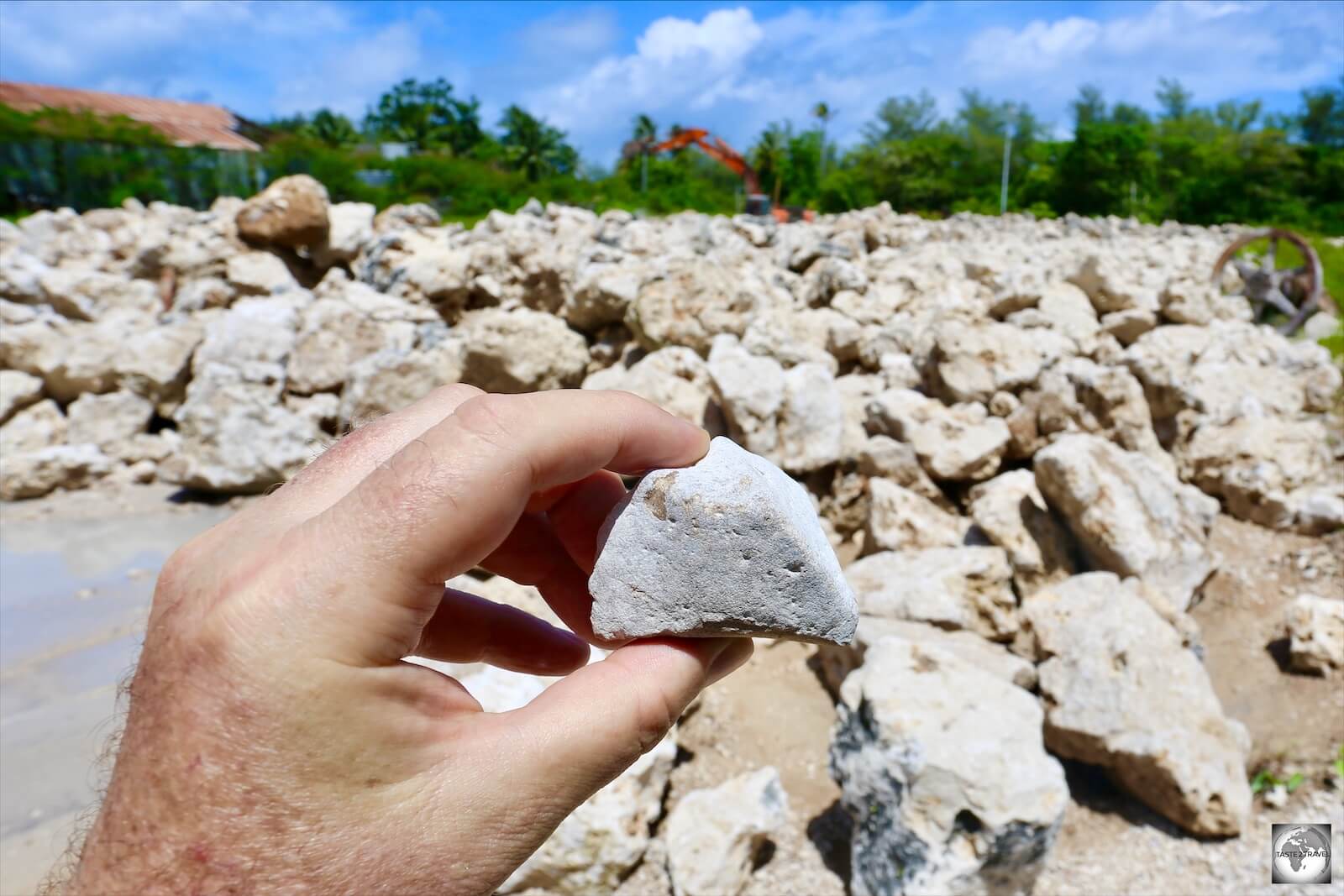
A quarry of phosphate rocks at Topside.
How is Phosphate Used?

Phosphate being sorted into different grades at a mine on Topside.
Phosphate is one of three key ingredients which are used in fertilisers. Normally, fertilisers are labelled with an ‘N-P-K’ rating, with phosphate being the ‘P’ component; nitrogen being the ‘N’ and potassium being the ‘K’.
An NPK value of ’10-5-5′ means that the fertiliser contains 10% nitrogen, 5% phosphate and 5% potassium. Phosphate is a key component for plant food and plants are key for human survival. The phosphate mined on Nauru is of an especially high quality, which makes for especially good fertiliser.
Phosphate on Nauru

Raw phosphate being graded prior to being trucked to the processing facility.
Geographically speaking, Nauru is an isolated phosphate-rock island. The raised phosphate plateau (‘Topside‘) which covers 80% of the island, has been one giant mine site for more than a century.
Since 1906, mining companies have worked this plateau, extracting the easily-reached, high quality, phosphate which lies close to the surface. The phosphate is interspersed between calcium carbonate (i.e. limestone) pinnacles.
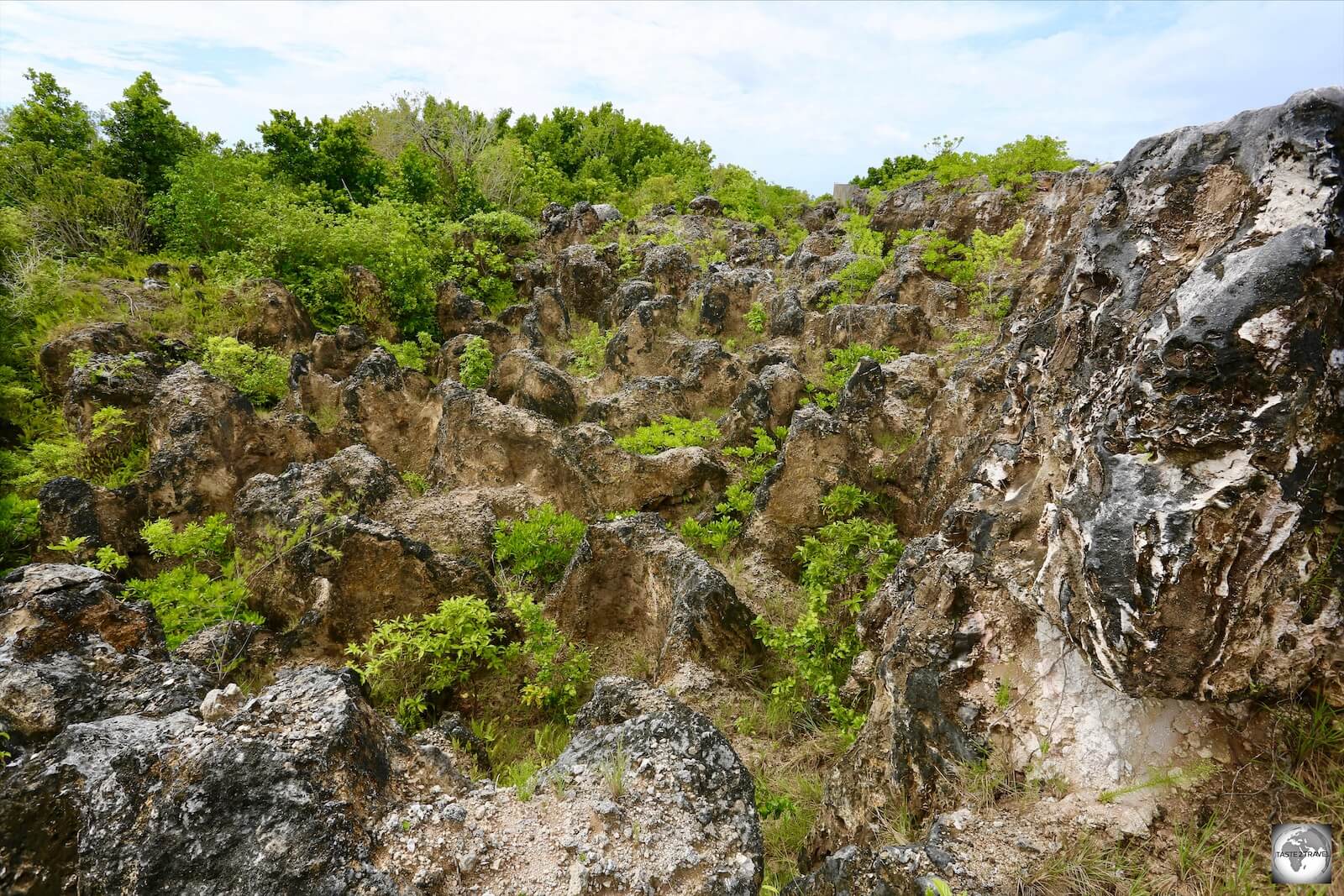
A former mine site on Topside. The exposed limestone pinnacles become blackened due to exposure to the elements.
Throughout much of its modern history, the economy of Nauru has been almost wholly dependent on phosphate exports.
Briefly, during the late 1960’s and early 1970’s, at the peak of the mining boom, Nauru boasted the highest per-capita income enjoyed by any sovereign state in the world.
More than a century of mining has taken its toll, with 80% of the nation’s surface having been strip-mined and left as a scarred, barren wasteland.

A view of discarded limestone rock at a mine on Topside. Large areas of the interior of Nauru feature such wastelands.
Following WWI, and the defeat of the Germans, Nauru, which was then a German colony, was given in trust to Britain, Australia and New Zealand. These three governments created the, Melbourne-based, British Phosphate Commission which took over the rights to phosphate mining on the island.
In the first year of mining – 5,000 kg of phosphate were shipped to Australia. Originally, phosphate was loaded by hand from small row boats onto larger ships which had to anchor beyond the shallow reef which surrounds the island.

A photo at the Nauru Museum, from 1910, shows the small row boats which were originally used to manually load phosphate onto ships which had to anchor beyond the shallow reef.
An increase in production was achieved with the construction, on the reef, of a phosphate-loading cantilever, which automated the loading of phosphate onto freighters anchored offshore.

A photo at the Nauru Museum showing the MV Sea Master being loaded with phosphate in 2016 at Cantilever #2.
The original Cantilever #1 was bombed by the Germans during WWII, on the 27th of December 1940. On this day, three German ships were able to easily launch attacks against an undefended Nauru, damaging the vital cantilever, which resulted in a disruption to phosphate exports and the rationing of farm fertiliser in Australia during the critical war years.
Following the war, Cantilever #2 was constructed and is the only one which remains operational today.

Built after WWII, Cantilever #2 is the only loader which remains functional today.
From 1919, until Independence in 1968, the responsibility for restoring the land and water resources lost by mining operations and providing compensation for environmental damage to the island was under the control of the governments of United Kingdom, New Zealand and Australia.

A truck used for carrying Phosphate to the processing centre.
Since independence the Nauru Phosphate Corporation, renamed in 2005 to the Republic of Nauru Phosphate Corporation have held the mining rights.
In 1989, the government of Nauru filed a case against the Australian government at the International Court in The Hague, claiming compensation for the rehabilitation of land mined under Australian administration. Despite a settlement having been reached, the mined interior of the island is still to be rehabilitated.
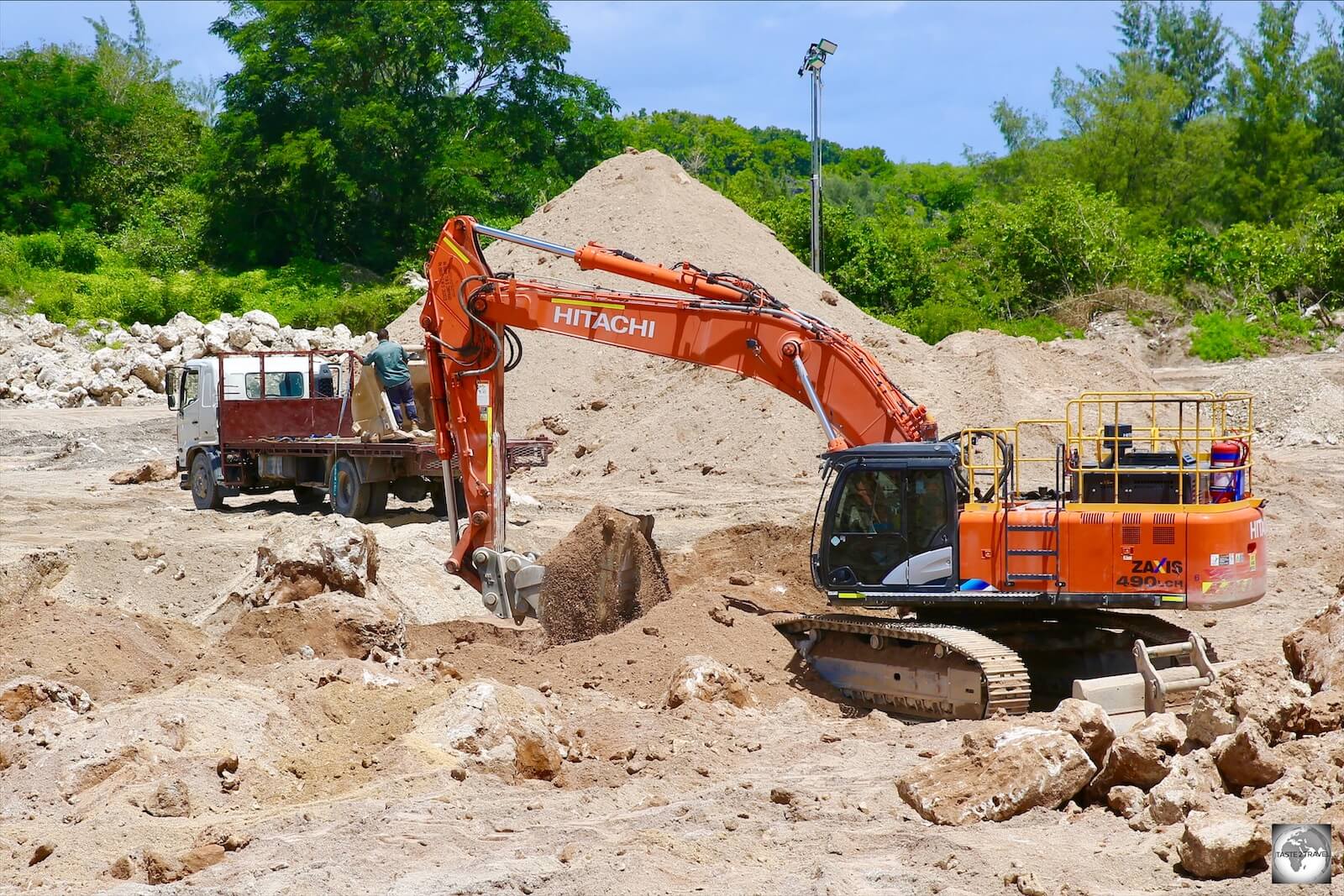
Small-scale phosphate mining at Topside in 2020.
In 2002, the mining industry collapsed, due to the virtual exhaustion of financially viable resources, although some small-scale mining can still be seen today and can easily be observed on a drive around Topside.
The gravel roads on Topside have been made by the Nauru Phosphate Corporation in order to access their mining grounds. These roads are open as public roads and provide access to both the mines sights and the Regional (Refugee) Processing Centres.
Now, almost all of the available phosphate has been mined for use in fertiliser. The residual pinnacles have left a jagged landscape that cannot be used for agriculture or forestry.
Scuba Diving

Ready to do some snorkelling among the limestone pinnacles at Anibare beach.
While on Nauru, I kept looking out at the warm, 29 degrees, turquoise water and wishing there was some way to go scuba diving on the reef which surrounds this remote island. How amazingly pristine it must be! I had failed to find any information online regarding scuba diving options on Nauru and no locals could provide information on scuba diving options.
Then, on my second last day on the island, I met with the very helpful and informative, Sean Oppenheimer, who is the owner of Capelle & Partners. Sean advised that there is a PADI-certified Dive Master resident on Nauru and that diving can be organised by first contacting Capelle & Partners.
For any Israelis who make it to Nauru, Sean also serves as the Honorary Consul for Israel. For any consular enquiries, he can be contacted at: israelnauruconsol@gmail.com.

A photo on the wall of the Capelle and Partners office shows Sean Oppenheimer with Jean-Michel Cousteau during his visit to Nauru.
Displayed on the wall of the Capelle and Partners office is a photo of Sean Oppenheimer with Jean-Michel Cousteau, the son of Jacques Cousteau, who visited Nauru in the early 1990’s to film a documentary “Nauru: The Island Planet” which focused attention on the environmental consequences of exploiting natural resources, i.e. Phosphate mining.
Fishing Charters

The wonderful staff at Capelle and Partners showing off their new banner ads which feature their car rental, accommodation and fishing charter businesses.
The deep (up to 2,000 metres), pristine waters which surround Nauru, offer some of the best game fishing on the planet. Fishing trips can be organised through Equatorial Gamefishing Charters, who operate two boats on either full-day or half-day trips.
The charter business is another offering from Capelle & Partners, who can also arrange car rental, accommodation and much more.
If you need to purchase any fishing equipment, you can do so from their fully stocked fishing supplies shop, which is located next to the supermarket entrance.
Equatorial Gamefishing Charters Contact Details:
- Website: https://www.facebook.com/equatorialgamefishingcharters/
- Address:
Capelle & Partners
Occidental Building
Ewa Beach
PO Box 5
Republic of Nauru - Telephone Numbers: +674 5571001 /+674 5571008 / +674 5571055 /+674 5571000
- Email: cpreservations@capelle.com.nr
Sightseeing

A wooden map of Nauru, showing the different districts, adorns the wall of the OD-N-Aiwo Hotel.
Island Tour

Visiting Buada Lagoon with my guide Ima.
The sights of Nauru can be visited during the course of one day – at a leisurely pace! The best way to experience the island is to engage the services of a local guide, such as the wonderful Ima who is a staff member at the Menen Hotel.
A tour with Ima, which can be arranged through the reception desk at the hotel, costs A$40 and takes as long as it takes. Since I had a rental car, I did the driving while Ima did the navigating and talking!
Having a local guide is worthwhile, especially on Topside, where some interesting WWII sights (built during the Japanese occupation of the island), are hidden away and impossible to find.
Then there’s the surprising Moqua Caves, located right under your nose but completely hidden and impossible to find without a local guide.
Highly recommended!
Around the Island
Yaren District
Although Nauru has no official capital, the district of Yaren serves as the administrative centre for the island. It’s here, at the southern end of the island that you’ll find the airport, Parliament House, Ministerial Building, Court House, Nauru Museum, Police Station, Fire Station, Schools and more.
Ministerial Building

A view of the Ministerial Building with the Nauru War Memorial in the foreground.
Located next to the Parliament House in Yaren, the Ministerial Building houses the offices of the members of the Nauru cabinet. The Cabinet is directly appointed by the President, and comprises the president, who presides over Cabinet meetings, and either four or five members of the parliament.

Located outside the Ministerial building in Yaren, the Nauru War Memorial is dedicated those who lost their lives in WWI and WWII.
Clearly displayed on the Ministerial building is the Nauru Coat of Arms. Designed at the time of Independence, it features a shield split into three parts; with the top part containing the alchemy symbol for Phosphorous; the lower-left part containing a black frigate bird, while the third part contains a sprig of ‘Calophyllum‘, a flowering tropical plant.

The Nauru coat of arms is displayed above the entrance of the Ministerial Building in Yaren.
Parliament House

A view of Parliament House, which is a unicameral parliament.
Located next to the Ministerial building in Yaren, the Parliament of Nauru is a unicameral parliament, i.e. it consists of a single chamber. The parliament has 19 members who are elected for a three-year term in multi-seat constituencies. The President of Nauru, currently Lionel Rouwen Aingimea, is elected by the members of the Parliament.

A portrait of the first President of Nauru, Hammer DeRoburt, is displayed inside Parliament House.
While you are free to visit and photograph Parliament house, photography is forbidden inside the chamber.
Naoero Museum

A view of the Naoero Museum with one of the locomotives from the old phosphate railway on the right. The railway was built by the Pacific Phosphate Company in 1907.
The Naoero Museum, which was opened on the 30th of January 2019, should be the first place you visit on Nauru. It is here that you’ll gain an understanding of the history of the island and be made aware of the various sights, which you can then visit as you tour the island.

Displays inside the Nauru museum tell the story of Nauru while a model map provides a useful overview of the island.
A model of the island provides a good overview of the different sites which can be visited. The friendly docent, who has a wealth of knowledge relating to Nauru, will ensure you receive the full story of the island before he lets you depart.

A close-up view of a traditional ‘Tribal Mat’. About the size of a place-mat, these were worn around the waist by woman with the distinct pattern indicating their tribe.
The story of the Tribal Mats, which are uniquely Nauruan, is especially interesting. If you wish to contact the museum via email, you can do so at: naurugovinfo@gmail.com
Moqua Caves

A surprising find on Nauru, the completely hidden Moqua Caves in Yaren.
Hidden away, off the main road, near the airport, the Moqua Caves are a series of underground caves which are filled with water from the underground lake known as Moqua Well.
This is a favourite place for locals looking to cool off on a hot day. The water, which is slightly salty, is refreshingly cool. Bring your swimmers!
Meneng District

A view of the southern end of Anibare Bay from the Menen Hotel.
Located on the southeast coast of Nauru, the Meneng district is home to the Menen Hotel (see the ‘Accommodation‘ section for more details), the largest hotel on the island and the place where most visitors stay. The hotel is located at the southern end of Anibare Bay.
Anibare District

A view worthy to be the cover photo for this guide. Limestone pinnacles, rising from the reef at the northern end of Anibare Bay.
Located on the east coast, the 2-km long Anibare Bay is the longest beach on Nauru. Considered the best beach on the island, the bay was formed by the underwater collapse of the east side of the volcano that underlies Nauru.
The bay is the most photogenic on the island (especially at sunrise) with a cluster of towering, limestone pinnacles rising from the reef at the northern end of the bay.

A WWII Japanese “pillbox” overlooks Anibare Bay.
Located midway along the beach is an abandoned Japanese, WWII-era ‘pillbox’ (a concrete dug-in guard post). The Japanese occupation of Nauru lasted for a period of three years, from the 26th of August 1942 until the 13th of September 1945.

The only harbour on the east coast, Anibare Harbour was created in 2000 as a commercial fishing port.
I did attempt to paddle and snorkel in Anibare bay during high tide but the presence of coral and sharp limestone rocks makes any swimming dangerous.

Although quite deep, the enclosed Anibare harbour provides the only safe swimming place on the east coast and is very popular with local kids.
The best place to swim on the east coast is inside the protected walls of Anibare Harbour where the water is deep and protected from currents. The harbour was built as a safe harbour for the small fleet of fishing boats with a fish market located at the harbour.
Always best to follow the locals, who swim within the protected walls of Anibare Harbour.
Ewa District

Located opposite the Capelle & Partner complex, Ewa beach is an ideal place to enjoy your takeaway meal or coffee from the Tropicana cafe.
On tiny Nauru, all roads lead to Ewa, and specifically, the Capelle & Partners complex which includes the largest supermarket on the island, a bottle shop, the Buns in the Sun bakery, the Tropicana café, the Ewa Lodge and the fishing gear shop. This is a busy corner of the island, with the facilities attracting a constant stream of locals.

A view of Ewa beach.
Aiwo District

The ruins of Cantilever #1, which was bombed by the Germans during WWII.
If you enjoy photographing rusty, industrial relics, you’ll love Aiwo. Sitting on the reef are the ruins of Phosphate Cantilever #1 which was bombed by the Germans during WWII. North of this is Phosphate Cantilever #2, which was built after the war and is still operational.

Covid-19 panic shopping even hit remote Nauru with locals buying up supplies of rice at the Civic Centre.
If Nauru has anywhere which could be considered ‘downtown’ then its Aiwo district. Located a short drive from the airport and Yaren, Aiwo is home to the Civic Centre, where you’ll find the one post office and bank on Nauru.

Friendly Nauru youth, on a shopping trip to Civic Centre.
During my visit, the government announced that it would suspend shipping services to the island as part of its Covid-19 lock-down. This resulted in panic buying of rice, with locals purchasing huge supplies of rice from the Civic Centre supermarket.
Topside
The interior, high plateau area of Nauru is known as Topside. It is here that the island has generated its past wealth through phosphate mining, which has seen 80% of the island strip-mined
While the landscape has mostly been destroyed, there are a few interesting sights worth exploring, including reminders of the Japanese occupation and the very attractive oasis which is Buada lagoon.
In addition to the sights listed below, its worth driving to the mine sites to see how phosphate is extracted and processed (refer to the ‘Phosphate Mining‘ section for more on this).
Buada Lagoon

Tiny Buada lagoon has an average depth of 24 metres, with a maximum depth of 78 metres.
Located on Topside is the charming, green oasis of Buada Lagoon, which is surrounded by lush, tropical trees. If I lived on Nauru, I would live on the shores of Buada lagoon.
At just 0.13 km2, this tiny, landlocked, body of water (a large pond really!) is an endorheic lake, i.e. there is no outflow from the lake.
For centuries, prior to the arrival of Europeans, the tribes of Nauru used the lagoon for breeding milk-fish. Young milk-fish were caught in the surf and transferred to the lagoon. While many died, large numbers survived and were harvested once they reached a certain weight. An ancient version of a fish farm!
Command Ridge

One of the Japanese WWII-era, double-barreled anti-aircraft guns on Command Ridge.
At 65 metres, Command Ridge is the highest point of Nauru. During the Japanese occupation, this was used as a lookout post. It’s possible to climb the overgrown ridge to reach a large double-barreled anti-aircraft gun which is still on its original mount.

A view of the hiking trail on Command Ridge.
The guns are very well concealed on the ridge. There are no signs pointing the way and I would never have found them without having a local guide.

A tunnel, which was originally used to provide access to the interior of the gun.
If you have an interest in WWII history and relics, Nauru offers plenty of sights of interest. For more detailed reading, a detailed description of the various WWII sites has been published by Stan Gajda, who spent time working on the island back in the 1980’s and used his spare time to explore the WWII history of Nauru.
Japanese Prison

Abandoned prison cells of the Japanese WWII prison.
Hidden away, just off the road which leads to Buada Lagoon, is an abandoned Japanese WWII-era prison. With a complete lack of signage and a concealed entrance, which is through a gap in the trees, I would never have found the prison without my trusted guide, Ima, leading the way.

Nature is slowly reclaiming the abandoned prison cells of the Japanese WWII prison.
The various prison cells were used to incarcerate enemies of the Japanese in World War II and was no doubt the scene of war time atrocities against the Nauruan’s, which would explain why my guide, Ima, was not comfortable spending time here.
Accommodation

While on Nauru, I stayed in one of the seaside rooms at the Menen hotel.
There are precious few rooms available on Nauru and of those available, currently (2020) many are rented out on a long-term basis to the Australian government and private companies for the purpose of housing expatriate support staff who work at the Refugee Processing Centres or elsewhere.
The Australian pilots, who fly for Nauru Airlines, are housed at the excellent Ewa Lodge. A part of the Capelle & Partners enterprise, the Ewa Lodge offers the best accommodation on the island, if you can secure one of their few rooms. It’s worth contacting the company directly as they allocate five rooms for short term visitors.
Menen Hotel

The entrance to the Menen hotel, with a wing of ‘Shipping container’ rooms visible on the right.
The one sure bet on Nauru is the government owned, 119-room, Menen Hotel, which has been serving the people of Nauru since 1969. A hotel, whose star has faded, the Menen is the largest property on Nauru and one of the only properties where a room can be secured at short notice.
Built during the heyday of the Phosphate boom, the hotel today is old and tired and in need of a complete renovation, and in some cases a complete rebuild.

The Government-owned Menen Hotel celebrated its 50th anniversary in 2019.
Anywhere else, the Menen Hotel would be avoided, but on tiny and remote Nauru, where options are very limited, visitors have little choice but to stay here and management (or the Government) are under no pressure to improve the offering.

My old and tired, but spacious and comfortable, room at the Menen hotel, which cost A$185 per night.
Overlooking the beach in Meneng district, the 119 rooms are basic but comfortable, but at A$185 per night – not cheap. The hotel restaurant is one of the best on the island while the hotel bar, the Reef Bar, is the only bar on the island, although you can also enjoy a drink in the beer garden at the excellent The Bay restaurant.

The view from my balcony at the Menen hotel.
I enjoyed my stay at the Menen, and would recommend the hotel, purely because it’s the only real option for a short-term visitor.
Through the hotel reception, I was able to organise a rental car (see the ‘Rental Car‘ section below) and an island tour with the wonderful Ima (see the ‘Sightseeing‘ section for details).
The hotel also has one of the few ATM’s on the island which is convenient.
Payment for the rooms needs to be made in cash or by bank transfer to their Bendigo Bank account – no credit cards are accepted.
While visitors are (normally) accommodated in the two seaside wings of the hotel, much of the sprawling property has been developed into a small village of ‘shipping container rooms’ which are used to house support staff for the Refugee Processing centres.
The containers, which are stacked two-high, in long rows, are also used to accommodate regular visitors, should the seaside rooms be unavailable.

‘Shipping container’ accommodation at the Menen hotel is used to house Australian staff working at the Refugee Processing Centre.
Menen Hotel Contact Details:
- Reservations Manager: Mr Hansolo Boutu
- Website: No website.
- Address:
Menen Hotel
Republic of Nauru
PO Box 298 - Telephone Numbers: +674 5578020 / +674 5578021 /+674 5578022
- Email: menhotreservation@yahoo.com
Note: Response to emails can take time and can require following up.
Ewa Lodge

The rooms at the Ewa Lodge are located on the 1st floor of the Capelle & Partners building.
It seems that everything that is done by the team at Capelle & Partners is done to perfection and their accommodation option, the Ewa Lodge, is no exception.
Their modern, contemporary and stylish rooms (of which there are about 20) are the best on the island.
Unfortunately, the secret is out and many companies rent their rooms on a long-term basis to house their employees.
When the Australian pilots of Nauru Airlines stay overnight on the island, they stay at Ewa Lodge.

A room at the Ewa Lodge.
Source: Capelle and Partners
The good news is that five rooms are reserved for short-term guests, so it’s worth contacting the Accommodations Manager, Ms. Janelle Duburiya, to enquire about availability.
The lodge is located on the 1st floor of the Capelle & Partners building, above their supermarket, the largest on Nauru.
Also conveniently located downstairs is their bakery, ‘Buns in the Sun‘, and their café, ‘Tropicana café‘ (both of which are covered in the ‘Eating Out‘ section below).
Across the road is Ewa beach, which offers a sandy stretch of white-sand.

The different businesses of Capelle and Partners.
Source: Capelle and Partners
Having spent time with the team at Capelle & Partners, it is clear that they see the tourism potential of Nauru, and are busy developing that potential.
Just as importantly, this small, local, family-run conglomerate has the resources to be able to develop and offer services which will allow visitors to maximise their travel experience while on Pleasant Island.
Ewa Lodge Contact Details:
- Accommodations Manager: Ms. Janelle Duburiya
- Website: http://capelleandpartner.com/ewa-lodge-accommodation/
- Address:
Capelle & Partners
Occidental Building
Ewa Beach
PO Box 5
Republic of Nauru - Telephone Numbers: +674 5571055 / +674 5571000 / +674 5571001
- Email: cpreservations@capelle.com.nr
Goodworks
The newest accommodation option on Nauru, Goodworks offers apartments which are housed in shipping containers.
Located in Aiwo district, a short drive from the airport, Goodworks offer shared apartments for AUD$110, and studio apartments for AUD$130.
The hotel also has cars available for rent.
Budapest Hotel
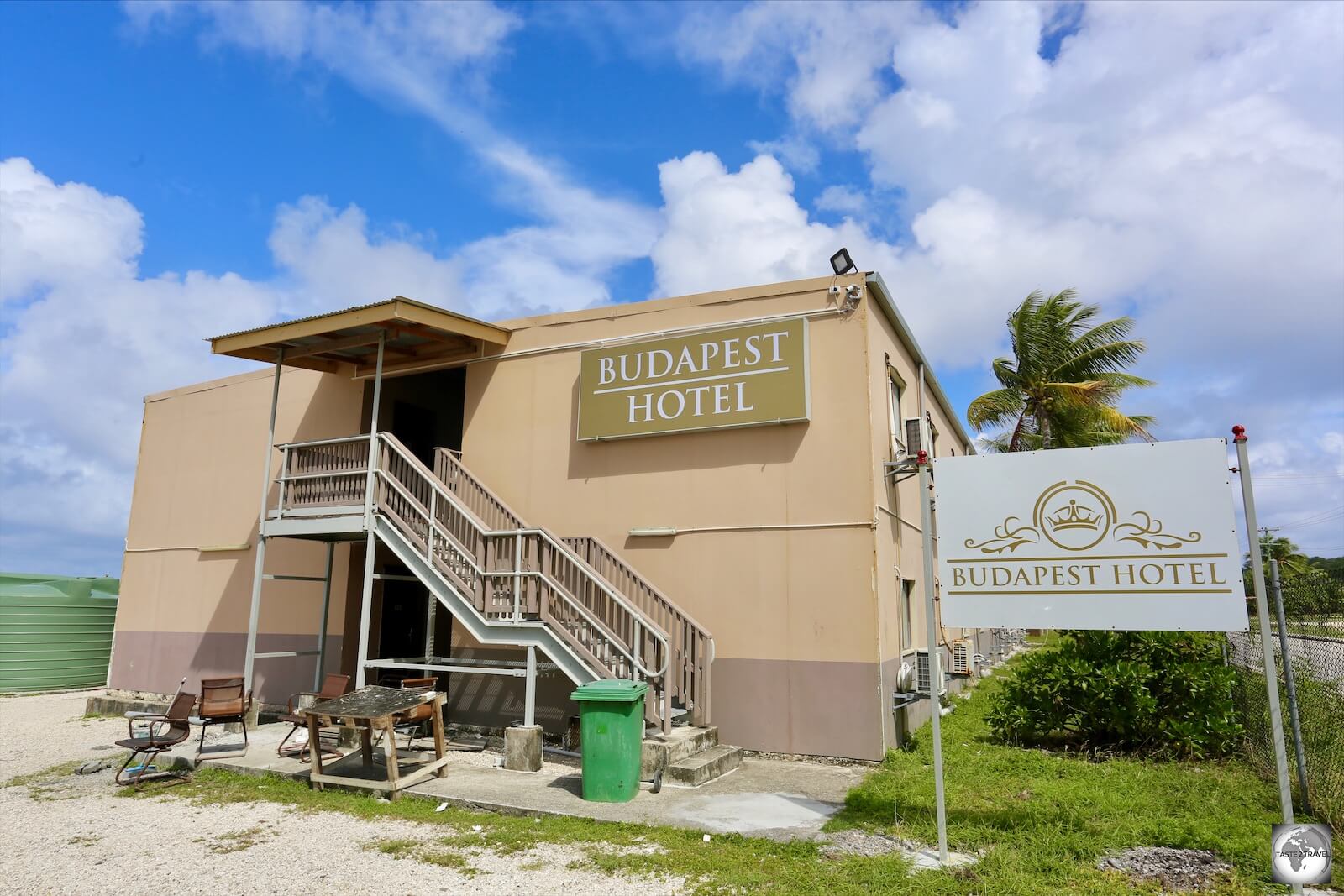
Located on beautiful Anibare beach, the rooms at the Budapest Hotel are currently fully occupied, providing accommodation to Refugees.
Located on Anibare beach, a short drive south of Ewa Lodge, the rooms at the very utilitarian Budapest Hotel are currently booked out on a long term basis, housing refugees who are awaiting processing.

One of the very basic, but functional, rooms at the Budapest Hotel.
Source: http://budapesthotelnauru.com/
At the time of my visit, the Indian management were busy renovating the property and advised that the hotel will not be open to short-term visitors anytime soon.
When it does re-open, this 2-story hotel, which was inaugurated in 2017, offers 30, relatively basic rooms in two buildings which have been built with a focus on functionality rather than aesthetics.
Budapest Hotel Contact Details:
- Managers Name: Tariq
- Website: http://budapesthotelnauru.com/
- Address:
Island Ring Road
Anabar
Nauru - Telephone Number: +674 5583697
- Email: tariq@radianceintl.com.au
OD-N-Aiwo Hotel

The 3-storey OD-N-Aiwo Hotel is the tallest building on Nauru.
As with the Budapest Hotel, the old and tired rooms at the OD-N-Aiwo Hotel are fully booked on a long term basis, housing support staff from the Refugee Processing Centre.
At the time of my visit, the completely disinterested receptionist advised the hotel was currently closed to short-term visitors.
This three-storey complex, which is located in the heart of the downtown area in Aiwo district, has the distinction of being the tallest building on Nauru.
The lobby also features some funky displays which are worth a peek.

A model of an old Air Nauru plane hangs from the ceiling of the reception at the OD-N-Aiwo Hotel.
Located 2 minutes from the airport, the hotel is a short walk from the Civic Centre which is the main commercial centre on Nauru, offering a supermarket, post office, bank, the main Digicel store.
OD-N-Aiwo Hotel Contact Details:
- Website: No Website
- Address:
PO Box 299
Aiwo District
Republic of Nauru - Telephone Numbers: +674 444 3591 / +674 444 3720
- Email: odnaiwo@yahoo.com
Airport Homestay
There is one Airbnb property on Nauru. Nauru Airport Homestay Poe offers private rooms in Yaren, next to the airport, for around A$115 per night. An ideal option for those in transit.
Eating Out

Fish ‘n’ Chips at the Anibare Restaurant at the Menen hotel, where the local fish was always excellent.
As with accommodation options, dining options on Nauru are limited.
This is an island of 10,670 souls, most of whom eat at home.
Due to the poor soil, almost all produce is imported, with Nauru Airlines operating a weekly cargo flight, every Friday, from Brisbane.
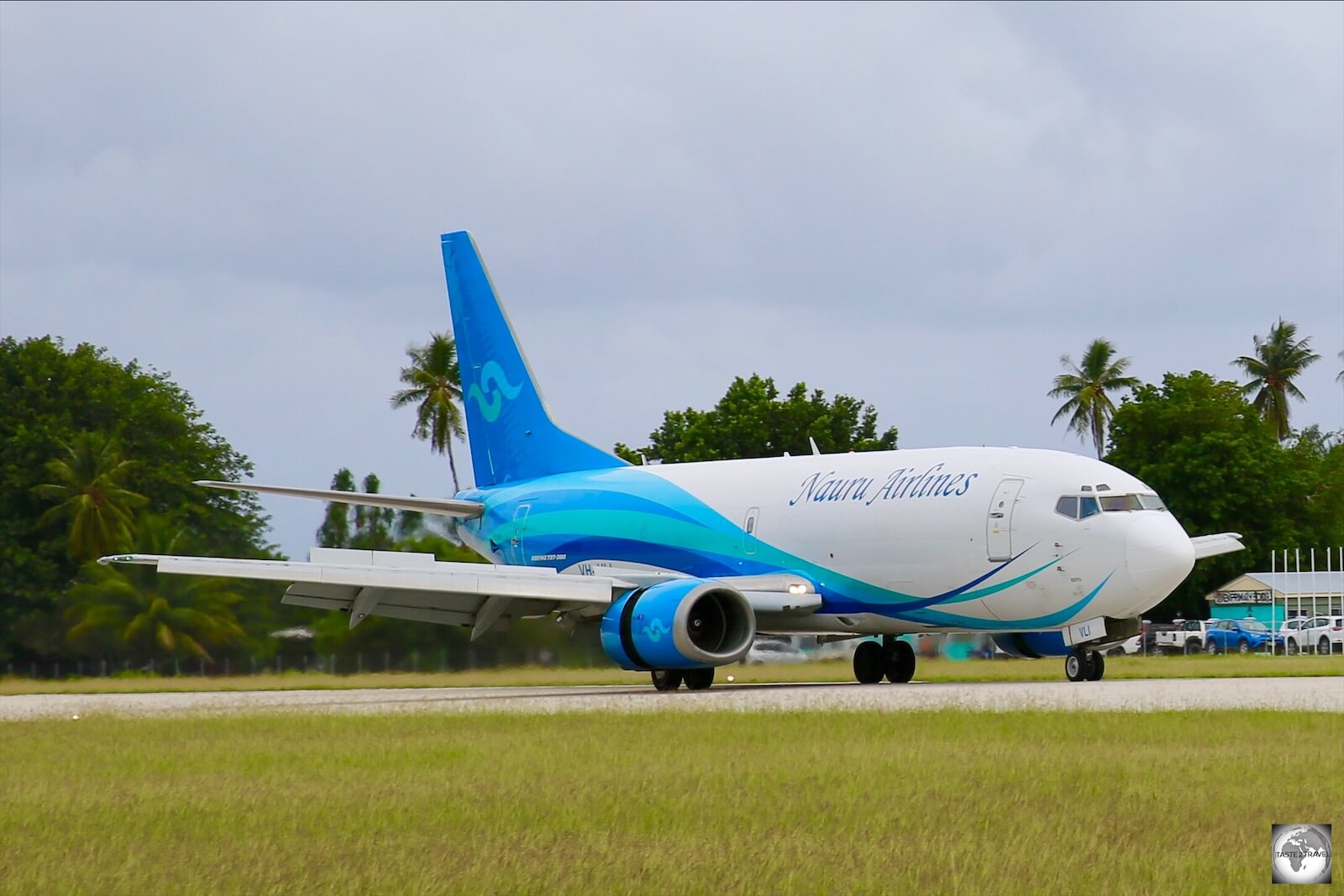
The Nauru Airlines cargo plane, a converted Boeing 737, arriving at Nauru airport.
There are just two decent dining options on Nauru.
In order of preference, they are:
Apart from these two options, there are a string of cheap and cheery Chinese restaurants, with the best of them being the Oriental Restaurant, which is located on the ground floor of the OD-N-Aiwo Hotel.
While on the island, I ate local reef fish most evenings, which was always fresh and tasty.
Restaurants
The Bay Restaurant
Owned by Capelle & Partners, The Bay Restaurant (Tel:+674 557 1111) is the best restaurant on the island.
Located on the Island Ring road in Anibare bay, this popular restaurant is the ‘go-to’ place for expats looking for a night out.
With a spacious, leafy beer garden out the back, the restaurant is especially popular during happy hour when bottles of Australian beer can be purchased for $4.50 each.
The menu includes lots of international favourites including pizza, hamburgers and chips (A$10), curries, fresh Fish and Chips, Club sandwiches and much more.
The friendly, enthusiastic staff provide a very good level of service, which isn’t always assured on Nauru.
Anibare Restaurant

The dining room at the Anibare Restaurant, where the chairs are covered in the national colours.
Named after the long bay on which the Menen Hotel is located, the Anibare Restaurant offers surprisingly good meals.
I always ordered the fresh fish of the day and was never disappointed.
Oriental Restaurant

A not-so-busy Oriental Restaurant at lunchtime.
Cafés

A Flat white coffee and a freshly made cupcake at the Tropicana café.
The best coffee on Nauru is served at the Tropicana café, which is part of the Capelle & Partners conglomerate.
Tropicana Café
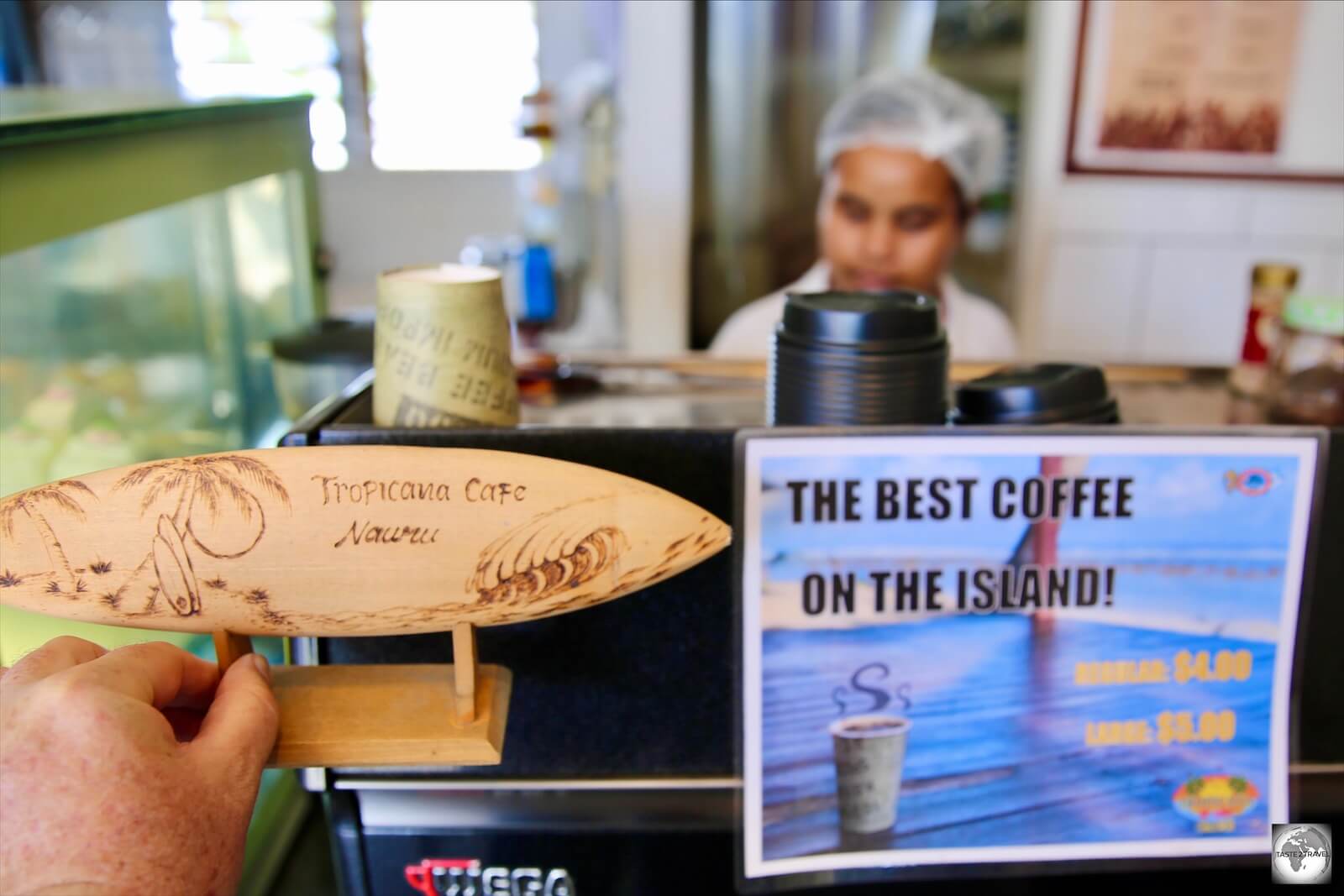
The Tropicana café claims to offer the best coffee on Nauru.
Another offering from the busy folks at Capelle & Partners, the Tropicana café is located in their supermarket complex in Ewa.
Apart from very good coffee, the café offers a menu of favourite takeaway food and drinks, which makes this a popular stop for locals at lunchtime.

Always armed with an amazing smile, Doris is one of the friendly staff members at the Tropicana café.
The café offers fast foods, wraps, sandwiches, burgers, sushi, hot meals and freshly baked cakes which are prepared next door by the team at the ‘Buns in the Sun’ bakery.

The lunchtime crowd at the Tropicana café.
Bakeries
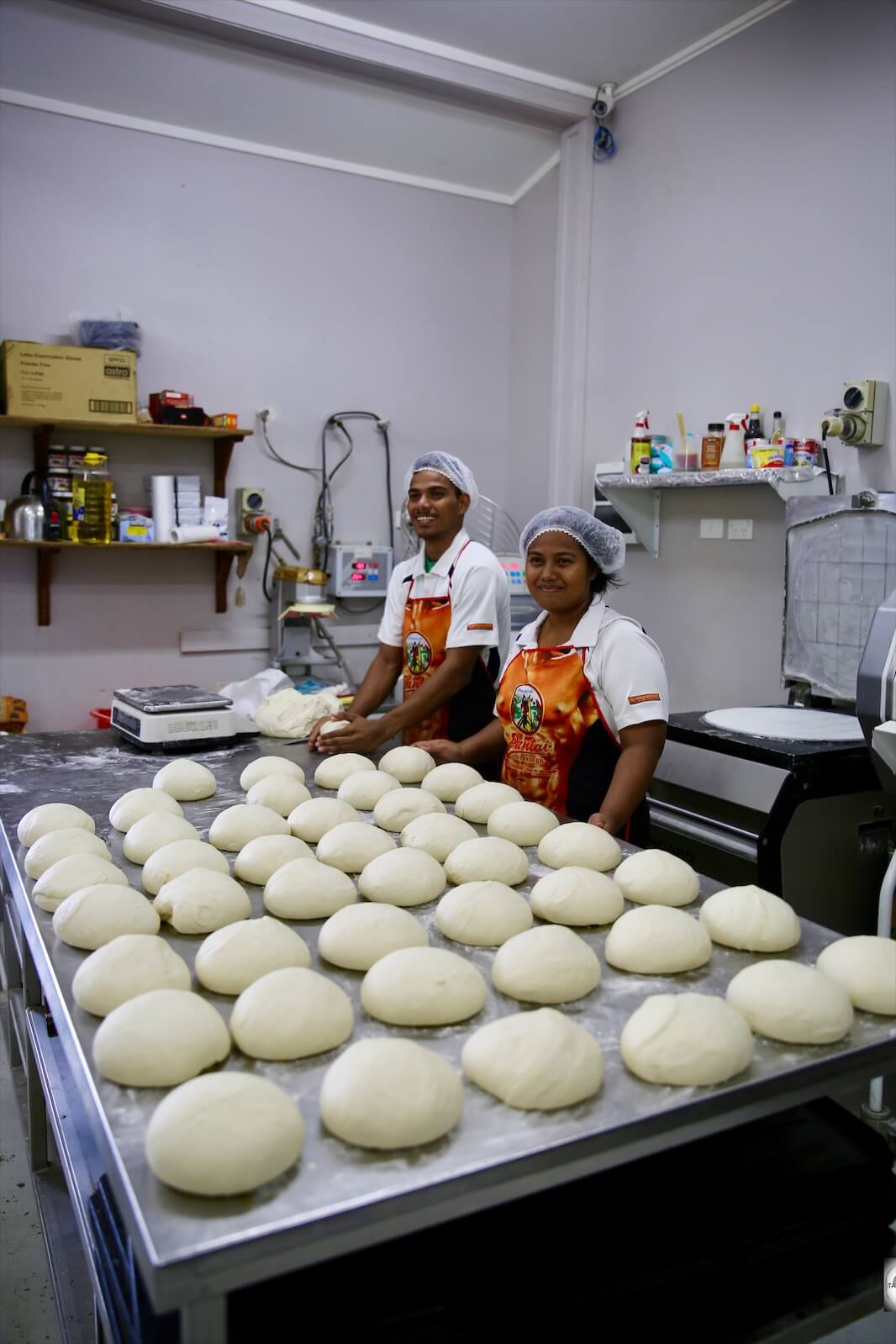
Staff at ‘Buns in the Sun’ preparing fresh bread rolls.

The award for ‘Best Bakery on Nauru‘ goes to… ‘Buns in the Sun‘.
Part of the Capelle & Partners conglomerate, this excellent bakery, which is located at their supermarket complex in Ewa, was established using equipment supplied by Bakers Delight, the large Australian-owned bakery franchise chain which has outlets throughout Australia, New Zealand and Canada.
The friendly, well-trained, young, international team of bakers produce the best bread on the island.
They also bake the best meat pies and sausage rolls on Nauru, which make for a great lunch which can be enjoyed across the road from the bakery, on the wonderful white sands of Ewa beach.
Bars

The outdoor area at the Menen Hotels’ Reef Bar.
There is just one bar/club on Nauru, the Reef bar at the Menen Hotel.
It was very quiet every night I stayed at the hotel, with just a few patrons sitting outside on the garden furniture drinking beers.
The bar opens each evening around 6:30 pm, or whenever the staff show up for work.
Visa Requirements

My Nauru tourist visa.
All visitors to Nauru must obtain a visa in advance, unless they hold a passport from one of 15 countries.
To check the current requirements, please refer to the Visa Policy of Nauru.
The most current source of information regarding the Nauru visa application process can be found on the Nauru Tourism website.

The A4-size Nauru arrival form, which is comprised of three separate declarations for three different departments.
Online Visa Application Process

My ‘Visa Grant Notice’ letter, which took Nauru immigration one month to issue.
Visas can be obtained online, which is very convenient since there are just four diplomatic missions around the world.
A description of the online visa process is included here.
For a country which was once named Pleasant Island, times have changed with the ‘welcome mat’ having been removed.
The only unfortunate aspect of planning a visit to Nauru is completing the Visa Application process, with seems to be unnecessarily long.
Application Form
Click here to download the Nauru Visitor Visa Application Form
Journalist Visas
Due to a number of global media reports, which have focused on the Refugee Processing Centres, and created a negative image for the country, Nauru Immigration screen all visitors to ensure they are not journalists.
The current visa fee for a journalist is A$8,000, which is non-refundable.
Apparently, it only took a few refusals to stop media organisations from applying for them.
If you are applying for a visa, you will be required to show proof of your occupation – which should not be ‘Journalist’.
Nauru Consulate Brisbane
Visas are issued by the Consulate of Nauru in Brisbane.
Contact details:
- Address: Level 3, 99 Creek Street , Brisbane, QLD 4000
- Office Hours: Monday to Friday 9.00 am – 5.00 pm
- Telephone: +61 07 3220 3040
- Email: nauru.consulate@brisbane.gov.nr
Nauru Immigration Contact Details
The following email addresses should be used for contacting Nauru Immigration:
- General email address: visa@naurugov.nr
- Senior Immigration Officer (Rajeev): rajeevnauruimmigration@gmail.com or rajeev.keerthiyil@naurugov.nr
- Senior Immigration Officer (Darlene): darlenenauruimmi@gmail.com
Visa Application Requirements
In order to apply for an Online Visa, you should first email Nauru Immigration and ask them to confirm the current requirements.
When I contacted them (January 2020), I received the following reply:

Nauru Visa Application Requirements.
Visa Processing Timeline
Following is a timeline of my Visa application.
From the time I submitted all my documents, it took Nauru Immigration one month to process my application and issue my ‘Visa Grant Notice‘ letter (pictured above).
- 21st of January: I submitted all required documents to Nauru Immigration via email.
- 4th of February: After receiving no response to my submission email, I emailed Nauru Immigration, asking them to confirm that they had received my application. I received no response to this email.
- 10th of February: I emailed Nauru Immigration again, asking them to confirm that they had received my application. Rajeev responded asking me to re-confirm my itinerary and to provide proof of my occupation, which had to be stated on an official document. I reconfirmed my itinerary and provided an official document which stated my occupation.
- 14th of February: I emailed Rajeev to enquire as to when my visa would be issued.
- 17th of February: I received an invoice from Nauru Immigration for A$50 which was the Visa application fee. This was paid via bank transfer to an account at Bendigo Bank using instructions provided by Nauru Immigration. Credit cards cannot be used to pay the visa application fee.
- 18th of February: I finally received my Visa Grant Notice, which I then presented at the airport upon arrival on Nauru in exchange for my Visitor Visa, which was stamped into my passport.
Following is a copy of the Visa fee payment invoice with the bank accounts details for Nauru Immigration.

Nauru Visa Fee Payment Invoice.
Getting There

Nauru International Airport Terminal.
Air

The Nauru International airport terminal building.
The only way to arrive on Nauru is by air, with all flights arriving at Nauru International Airport (IATA: INU) which is the only airport on the island.

Early morning departure from Nauru back to Brisbane.
Flight Connections
The only airline operating flights to Nauru is the national carrier, Nauru Airlines.
The airline offers (updated: August 2024) regular connections to Brisbane, Koror (Palau), Majuro (Marshall Islands), Nadi (Fiji), Pohnpei (Micronesia) and Tarawa (Kiribati).
The airline’s fleet consists of four Boeing 737-300 passenger aircraft plus one dedicated Boeing 737-300 cargo aircraft.

The Nauru Airlines check-in desks at Brisbane airport.
I flew on a return ticket from Brisbane to Nauru.
If you book a flight with the airline which involves a transit stop (e.g. Brisbane to Marshall Islands via Nauru), you will be admitted into Nauru without having to go through the tedious Visa process.
Nauru Airlines

Nauru Airlines route map – as of August 2024.
Nauru Airlines offer regular connections to many destinations in the Central Pacific, including, of course, Nauru itself, from their base at Brisbane International Airport.
An especially useful connection, for those already travelling in the South Pacific, is the airline’s regular flight from Nadi (Fiji) which offers connections to the Central Pacific.
Email address of the airline’s Brisbane office: book@ourtravel.com.au
Transiting Nauru
Depending on your flight connection, you could have an overnight stay on Nauru which would count as a visit for those country-counters who simply wish to tick Nauru off of their ‘Countries Visited’ list without going through the visa process.

My boarding pass for my flight from Brisbane to Nauru.
My flight experience with Nauru Airlines was very pleasant. The crew were friendly and professional, with the Cabin crew being comprised of Nauruan’s and the pilots being Australian.
The airline uses Brisbane Airport as its maintenance and administration base which makes a whole lot of sense as all services are readily available there.

The only view on the 4.5-hour journey from Brisbane to Nauru is of the vast Pacific Ocean, with the occasional, remote atoll appearing below.
The flight time on the 3,341 km (2076 mi) trip from Brisbane to Nauru is 4 hours, 39 minutes. The entire flight is spent over the Pacific Ocean, with the occasional remote atoll punctuating the vast, monotonous expanse of blue.
These atolls are the dream destinations for the competitive travellers on websites such as Most Traveled People – adventurers who spend their time travelling around the globe, aiming to set foot in every country, and on every speck of land in the ocean.
Flight Costs

The booking screen from the Nauru Airlines website shows typical tickets costs.
As a monopoly operator, Nauru Airlines is able to charge what they like, and since most passengers are travelling to the island on business, or government, expense accounts, airfares are not cheap.
Flights are sold in one-way segments and in different price categories.
The cheapest category is Pacific Super Saver, with a one-way ticket from Brisbane to Nauru typically costing A$679.
On certain days, this airfare might not be available with the next category of ticket, Pacific Saver, costing around A$950 one way.
It’s always best to book as far in advance as possible.
Brisbane Airport Accommodation
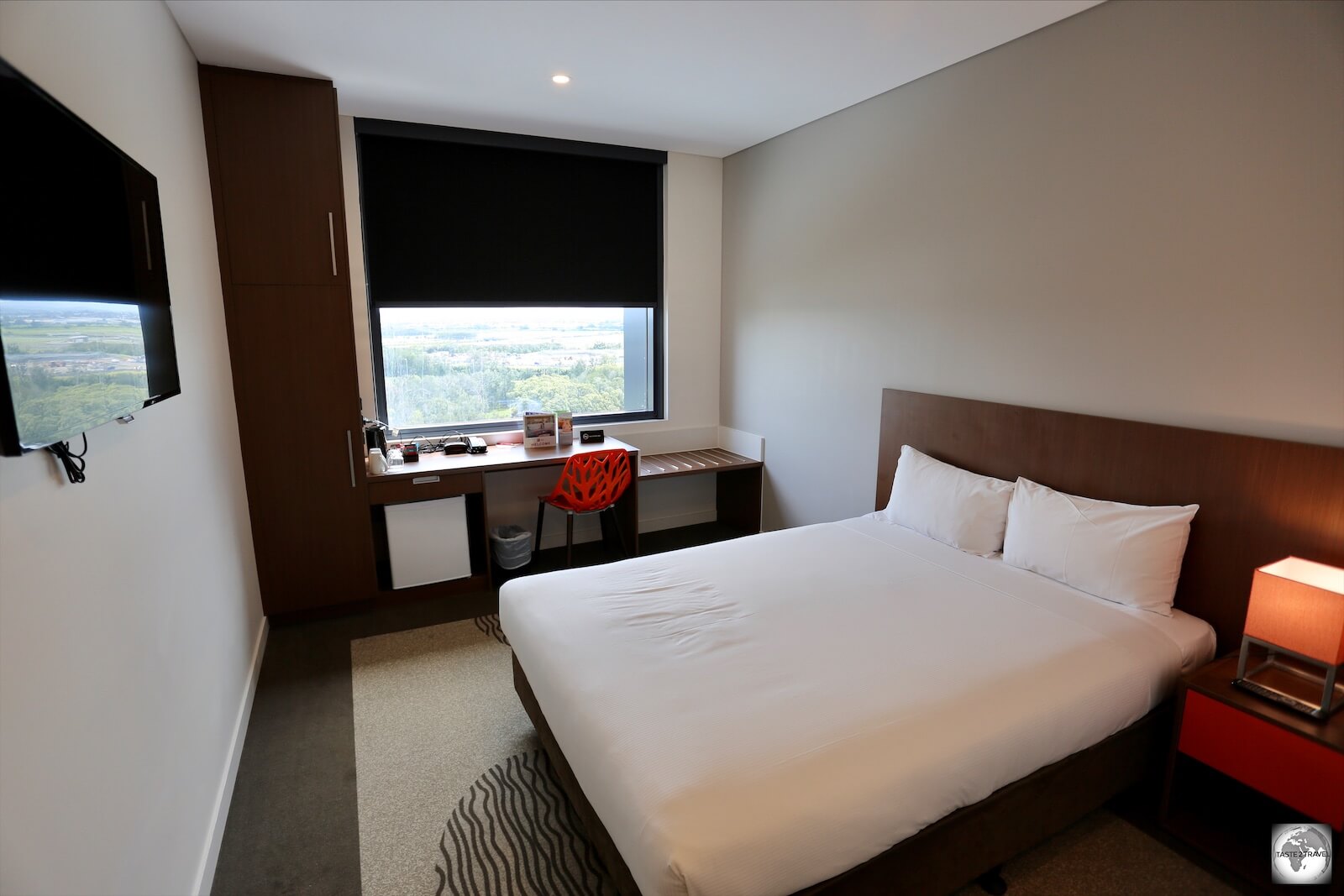
The Brisbane Airport Ibis hotel offers great rates and an unbeatable location directly opposite the international terminal, a short walk from your Nauru Airlines flight.
If staying in Brisbane before your flight to Nauru, I recommend staying across the road from the International terminal at the Brisbane Airport Ibis hotel.
The hotel offers comfortable rooms at reasonable rates with a wonderful breakfast served in the morning. The terminal is across the road from the hotel, making the Ibis a very convenient option for those travelling on the early morning flight to Nauru.
Destinations
Nauru Airlines Flight Schedule
The airline’s flight schedule is issued on a monthly basis.

An aerial photo at the Nauru Museum, clearly shows the runway extension which protrudes out over the coral reef.
Airport Transport
You can either walk or call ahead to your hotel to organise a transfer.
Sea
Forget it!
There is no way to reach Nauru by sea, unless you organise a berth on a container ship with a company such as Pacific International Lines (PIL).
Getting Around

There’s never any rush hour on the Island Ring road, the islands’ one long main road.
Public Transport

A private bus on Nauru.
There is no public transport on Nauru.
There are a few school buses and a few private mini-buses which transport refugees from their accommodation to the processing centres.
Walking/ Cycling
The distance from the most southern point of Nauru to the most northern point is just 9 km via the Island Ring road. The distance around the entire Ring road is 19 km (12 mi), making Nauru one country you could easily cover on foot in less than a day.
Rental Car

My rental car at Anibare Bay with the blue and white colours painted on the palm trees representing the colours of the AFL (Australian Rules football) team which the district supports.
The best way to maximise your time on Nauru is to rent a car. Nauru is so small that it takes less than one hour to drive around it. The 19-km Island Ring Road circles the island and is paved, however this is not the case for most of the interior roads on Topside, which are gravel.
Trivia: An interesting piece of trivia is that the national sport of Nauru is AFL (Australian Rules Football). The sport was played by Nauruan school children in the 1930’s in schools in Victoria, Australia – the home of AFL. One of these school children was Hammer DeRoburt, the first president of Nauru who was a keen promoter of AFL in Nauru.
The sport today enjoys a high participation rate among Nauruans, and each district on the island follows one particular team in the Australian national league. They show their loyalty by painting the trunks of the palm trees, which line the Island Ring road in their district, with their team colours.
The good news is that you will not require a navigation device on Nauru. With one circular ring road following the coast, you simply keep driving until you return to your starting point. While distances are small and fuel consumption is minimal, unleaded fuel costs a whopping A$2 per litre!

The interior roads on Topside are gravel surfaced, having been built by the Phosphate mining company to provide access to mine sights.
The speed limit on the island is 50km/h but many locals would never dream of driving at such a speed. The pace of life on the island is slow and relaxed – no one is rushing anywhere!
Seat belts are optional, hand brakes are never needed on the flat coastal terrain and as for locking your car – where would any would-be car thief disappear to? It’s all very leisurely and relaxed.

When planes are present at Nauru airport, this portion of the Island Ring road, which doubles as the taxiway and apron at the airport, is closed to traffic.
One strange quirk on the island is that a small section of the Island Ring road forms part of the taxiway and apron area at the airport. Whenever a plane is present, the road is barricaded closed. A second, newer road provides an alternative route around the perimeter of the airport, along the coast.
There are two contacts for rental cars on Nauru, Capelle & Partners and Ms Bena Fritz:
Capelle & Partners
This is one company which has all bases covered. C&P have a fleet of 8 Toyota Hilux vehicles which cost A$100 per day or 2 Toyota RAV4 vehicles for A$90 per day.
Contact Details for Capelle & Partners
- Website: http://capelleandpartner.com/
- Telephone Numbers: +674 5571055 / +674 5571000 / +674 5571001
- Email: cpreservations@capelle.com.nr

My rental car alongside one of the Japanese WWII pillboxes (concrete dug-in guard post), which can be seen along the coast of Nauru.
Bena Fritz
I rented a car for A$80 per day through Ms Bena Fritz, who maintains a small fleet of 4WD vehicles. Bena, who was recommended by the Menen Hotel, dropped the car to me at the hotel and allowed me to leave the car at the airport when I departed.
Contact Details for Bena Fritz
- Telephone: +674 54567187
That’s the end of my travel guide for Nauru. I look forward to hearing from anyone who uses this guide in planning a trip to Pleasant Island.
Safe Travels!
Darren
Follow me on Instagram:
Further Reading
Other travel reports from the Pacific region:
Nuru Travel Guide Nauru Travel Guide Nauru Travel Guide Nauru Travel Guide Nauru Travel Guide Nauru Travel Guide
Nauru Travel Guide Nauru Travel Guide Nauru Travel Guide Nauru Travel Guide Nauru Travel Guide Nauru Travel Guide
Nauru Travel Guide Nauru Travel Guide Nauru Travel Guide Nauru Travel Guide Nauru Travel Guide Nauru Travel Guide
Nauru Travel Guide Nauru Travel Guide Nauru Travel Guide Nauru Travel Guide Nauru Travel Guide Nauru Travel Guide
Nauru Travel Guide Nauru Travel Guide Nauru Travel Guide Nauru Travel Guide Nauru Travel Guide Nauru Travel Guide
Author: Darren McLean
Darren McLean is an Australian, full-time, digital nomad who has spent 37 years on a slow meander around the globe, visiting all seven continents, 189/ 193 UN countries and 240/ 251 UN+ countries and territories.
He founded taste2travel to pique one’s curiosity and inspire wanderlust.



